China Great Wall Computer A86 Notebook Computer User Manual Manual
China Great-Wall Computer Shenzhen Co. Ltd. Notebook Computer Manual
User manual
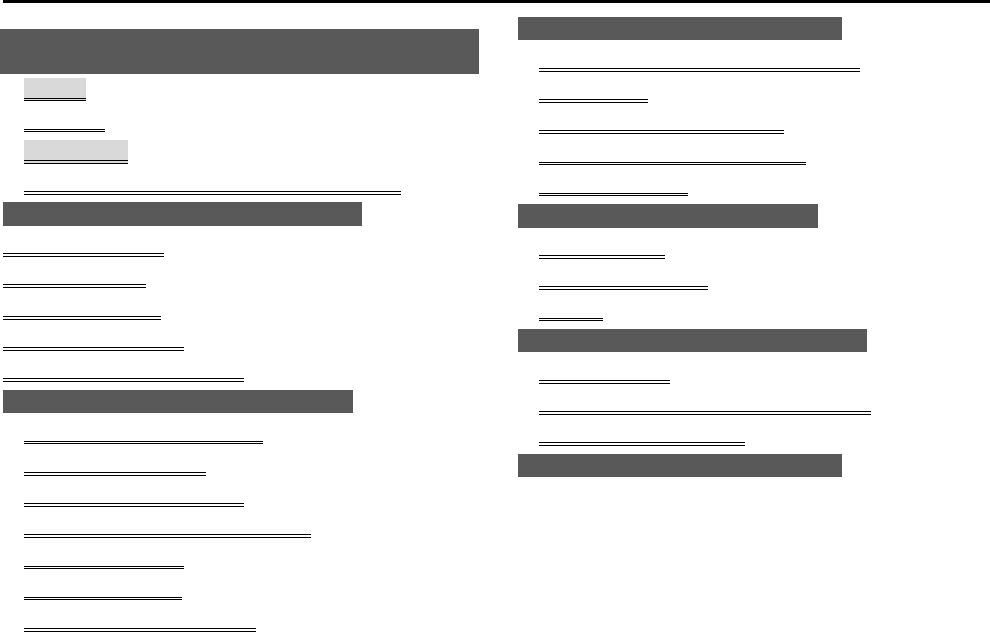
User’ Manual
CONTENTS
NOTICE.......................................................................... 2
WARNING ...................................................................... 2
TRADEMARK.................................................................. 4
BASIC CARE AND TIPS FOR USING YOUR LAPTOP ........... 5
CHAPTER 1 LEARNING THE LAPTOP................... 7
1.1 FRONT VIEW .......................................................... 8
1.2 LEFT VIEW............................................................ 10
1.3 RIGHT VIEW......................................................... 11
1.4 BOTTOM VIEW .................................................... 12
1.5 STATUS INDICATORS......................................... 13
CHAPTER 2 LEARNING THE BASICS................... 14
2.1 SELECT A PLACE TO WORK..................................... 14
2.2 FIX BATTERY PACK ................................................ 19
2.3 CONNECT AC ADAPTER......................................... 20
2.4 TURN ON/TURN OFF THE LAPTOP ........................... 21
2.5 USE TOUCH PAD .................................................... 22
2.6 USE KEYBOARD..................................................... 23
2.7 CARRYING YOUR LAPTOP ...................................... 30
CHAPTER 3 BIOS SETUP UTILITY........................ 31
3.1 ACTIVATE THE BIOS SETUP UTILITY .................... 31
3.2 SECURITY .............................................................. 31
3.3 SET BOOT PRIORITY ORDER ................................... 32
3.4 RECOVER ORIGINAL SETTINGS ............................... 32
3.5 TIPS & NOTICE ...................................................... 32
CHAPTER 4 INSTALL DRIVERS............................. 33
4.1 INSTALL OS........................................................... 33
4.2 INSTALL DRIVERS .................................................. 33
4.3 TIPS ....................................................................... 33
CHAPTER 5 POWER MANAGEMENT................... 34
5.1 AC ADAPTER.......................................................... 34
5.2 LITHIUM ION ( LI-ION) BATTERY PACK .................. 34
5.3 POWER MANAGEMENT ........................................... 39
CHAPTER 6 TROUBLESHOOTING........................ 40

User’ Manual
Page 2 of 43
Notice
Version (1.0)(2009.9)
The content of this manual may be improved and updated by our company from time to time.
Please accept our sincere apologies for any mistakes or carelessness maybe existed in this manual.
In case there is any discrepancy between physical product and this manual, the physical product should prevail.
This product is in line with Q/SIE75 Enterprise Standards of China Great Wall Computer Shenzhen Co., Ltd.
Principle
All the marks and tags existing in the user’s manual shall stand for the meanings as below:
…………………
The information with this mark and tag shall mean the potential problems lying in data loss, equipment damage or human
safety probably caused by un-proper operation. Please read the information carefully and remember in heart.
…………………
This mark and tag shall mean alarming the customer to note some operations which may cause damages.
…………………
This mark and tag shall mean showing the important information, general notice, word explanation, information for your
reference and relative general knowledge about how to use the Laptop, etc..
Warning
Changes may be made periodically to the information in this publication without obligation to notify any person who
possesses such revision or changes. Such changes will be incorporated in the new edition of this manual or supplementary
documents and publications. This company makes no representation or warranties, either expressed or implied, with respect
to the contents hereof and specially disclaims the implied warranties of merchantability or fitness for a particular purpose.

User’ Manual
Page 3 of 43
No part of this publication may be reproduced, stored in a retrieval system, or transmitted, in any form or by any means,
electronic, mechanical, photocopy, recording, or otherwise, without the prior written permission of China Great Wall
Computer Shenzhen Co., Ltd.
This device complies with part 15 of the FCC Rules. Operation is subject to the following two conditions: (1) This device may
not cause harmful interference, and (2) this device must accept any interference received, including interference that may
cause undesired operation. Changes or modifications not expressly approved by the party responsible for compliance could
void the user’s authority to operate the equipment.
Do not attempt to disassemble the Computer and battery by yourself. Non-expert handling of the devices may damage them.
The Notebook A86 is designed and manufactured not to exceed limits for exposure to radio frequency (RF) energy set by the
Federal Communications Commission (FCC) of the U.S. Government. These limits are part of comprehensive guidelines and
establish permitted levels of RF energy for the general population. The guidelines are based on standards that were
developed by independent scientific organizations through periodic and thorough evaluation of scientific studies. The
standards include a substantial safety margin designed to assure the safety of all persons, regardless of age or health. The
antenna installed in the lid (display) which provides at least 20 cm separation from the user body with the lid open (at top of
display section) inside; The exposure standard for WLAN employs a unit of measurement known as the FCC Part 1.1310(b)
(1), FCC Part 2.1091, and Maximum Permissible Exposure (MPE).
This equipment has been tested and found to comply with the limits for a Class B digital device, pursuant to Part 15 of the
FCC Rules. These limits are designed to provide reasonable protection against harmful interference in a residential
installation. This equipment generates uses and can radiate radio frequency energy and, if not installed and used in
accordance with the instructions, may cause harmful interference to radio communications. However, there is no guarantee
that interference will not occur in a particular installation.
If this equipment does cause harmful interference to radio or television reception, which can be determined by turning the
equipment off and on, the user is encouraged to try to correct the interference by one or more of the following measures:

User’ Manual
Page 4 of 43
-- Reorient or relocate the receiving antenna.
-- Increase the separation between the equipment and receiver.
-- Connect the equipment into an outlet on a circuit different from that to which the receiver is connected.
-- Consult the dealer or an experienced radio/TV technician for help.
Trademark
Intel®、Pentium®、Centrino™ 、Celeron® are registered trademarks of Intel Corporation.
Windows 2000®、Windows XP® 、Windows Vista® are registered trademarks of Microsoft Corporation.
All other brand and product names in this manual are trademarks or registered trademarks of their respective companies and
are used by Great Wall legally.

User’ Manual
Page 5 of 43
Basic care and tips for using your Laptop
Taking care of your Laptop
Your Laptop will serve you well if you take good care of it.
DO NOT place the Laptop on uneven or unstable work surfaces. Please kindly contact your local dealer if the casing has
been damaged.
DO NOT place drop objects on the top of the Laptop and do not shove any foreign objects into it.
DO NOT expose or use the laptop near liquids, rain, or moisture. DO NOT use the modem during an electrical storm.
DO NOT expose the Laptop to dirty or dusty environments.
DO NOT expose the Laptop to strong magnetic or electrical fields.
DO NOT expose the Laptop in extreme temperatures (below 0oC (32oF) or above 50o C (122oF)) or to direct sunlight.
DO NOT block the air vents of the Laptop.
DO NOT press or touch the display panel. Do not place it together with small items that may scratch or enter the Laptop.
DO NOT use the Laptop when the flight is taking off or landing;
Do not use the Laptop beside the apparatus of hospital to avoid disturbing the operating of the apparatus.
Taking care of your LCD panel
DO NOT touch or press the LCD panel of your Laptop with finger or sharp objects which may cause the damage to the panel.
Open and close the panel gently to avoid damage to the panel.
DO NOT place anything on the panel.
Keep the panel away from hardy items such as fastener, watch, buckle to avoid scrapping the panel.
DO NOT use any chemical lotion to clean the panel. Clean the panel with special cloth for the panel. Do not clean the dust
with hand which may leave your fingerprint on the panel.
DO NOT have any lotion into the panel.
Taking care of your AC Adapter
Here are some ways to take care of your AC Adapter:

User’ Manual
Page 6 of 43
DO NOT connect the adapter to any other devices.
DO NOT step on the power cord or place heavy objects on top of it. Carefully route the power cord and any cables away from
personal traffic.
When unplugging the power cord, do not pull the cord itself but pull the plug.
The total ampere ratings of the equipment plugged in should not exceed the ampere rating of the cord if you are using an
extension cord. Also, the total current rating of all equipments plugged into a single wall outlet should not exceed the fuse
rating.
Taking care of your battery pack
Here are some ways to take care of your battery pack:
Please use only batteries of the same kind as replacements. Turn the power off before removing or replacing batteries.
DO NOT tamper with batteries. Keep them away from children.
Dispose of used batteries according to local regulations. Recycle if at all possible.
Cleaning and servicing
When cleaning the Laptop, please follow these steps:
Power off the Laptop and remove the battery pack;
Disconnect the AC Adapter;
Use a soft cloth moistened with water. Do not use liquid or aerosol cleaners.
If any of the following occurs:
The Laptop has been dropped or the body has been damaged;
Liquid has been spilled into the Laptop;
The Laptop does not operate normally;
Please refer to “Troubleshooting”on page 30.
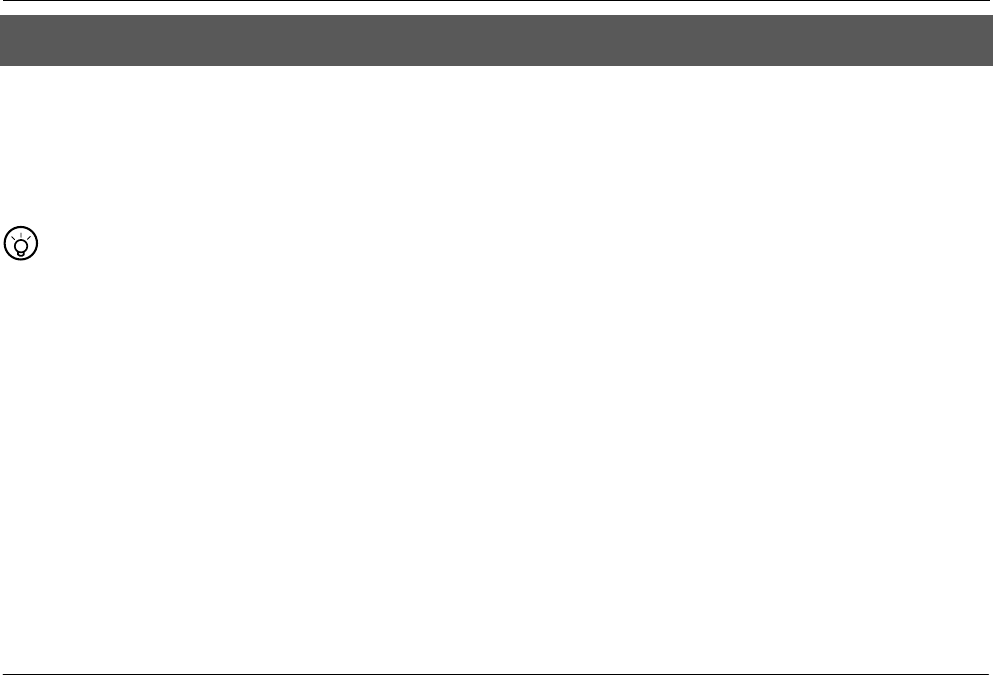
User’ Manual
Page 7 of 43
Chapter 1 Learning the Laptop
In this chapter, we will show you around your new Notebook.
Front View
Left View
Right View
Back View
Bottom View
Status Indicators
…………………
In this handbook picture male supplies the reference, the product outward appearance and matches colors the
type which possible and you actually purchases to have a part of difference, please take material object as.
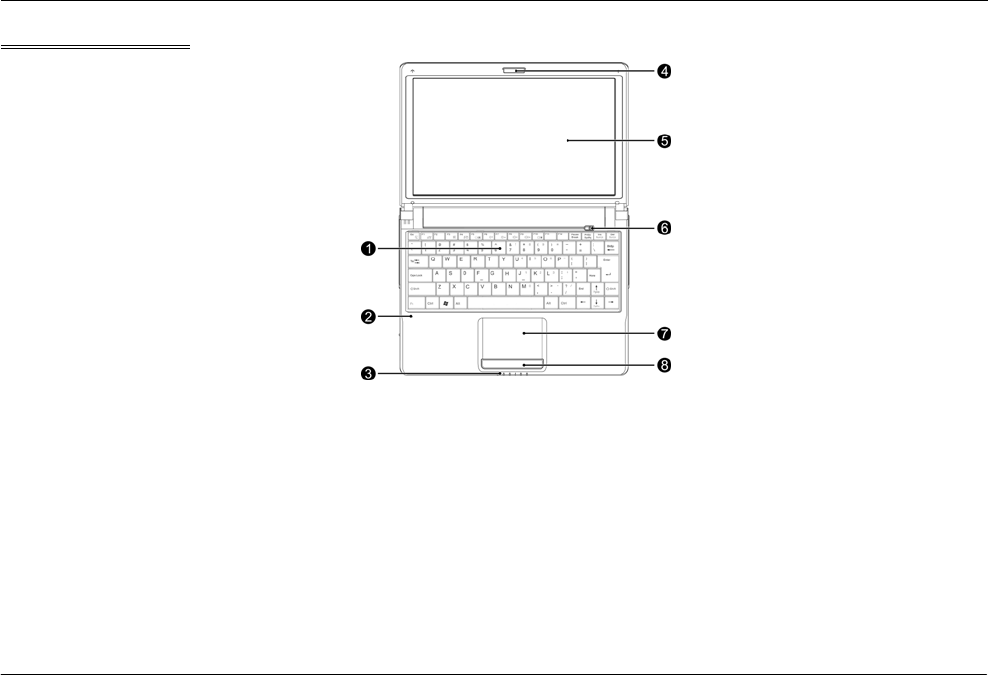
User’ Manual
Page 8 of 43
1.1 Front View
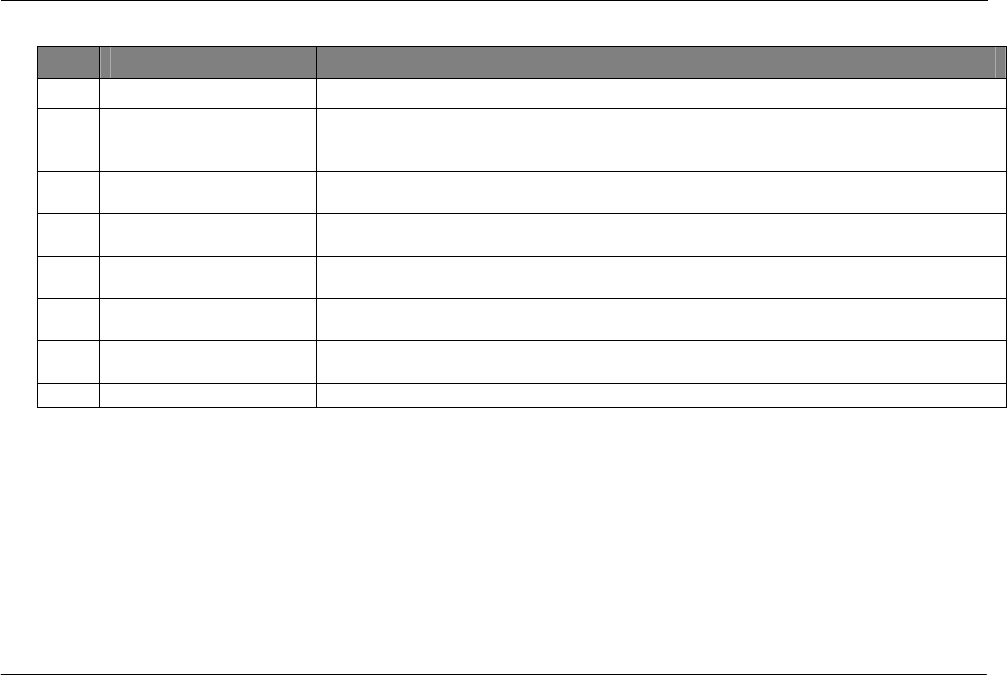
User’ Manual
Page 9 of 43
Icon Item Description
1 Keyboard Use to input the date
2 Array Microphone The built-in array microphone is an Omni-directional audio input device. It allows for
the stereo reception and transmission of voice and/or other audio data to any
program capable of accepting such input.
3 Status Indicator Lights The Status indicator lights correspond to specific operating modes. see the“ Status
Indicators”
4 Web Camera The built-in 1.3 Mega pixel camera allows you to snap a photo or create a video chat
or video conference within just a click. (This feature depends on your configuration.)
5 Display Panel The display panel is a color LCD panel with back lighting for the display of text and
graphics
6 Power Button This button turns your notebook on and off as well as puts it to sleep. (See
Suspend/Power On Button in the Power On section for more information.)
7 Touch Pad The Touch Pad device is a mouse-like cursor control with two buttons and a touch
sensitive movement pad.
8 Left Right key Choose Key,as same as the left right key of the mouse.
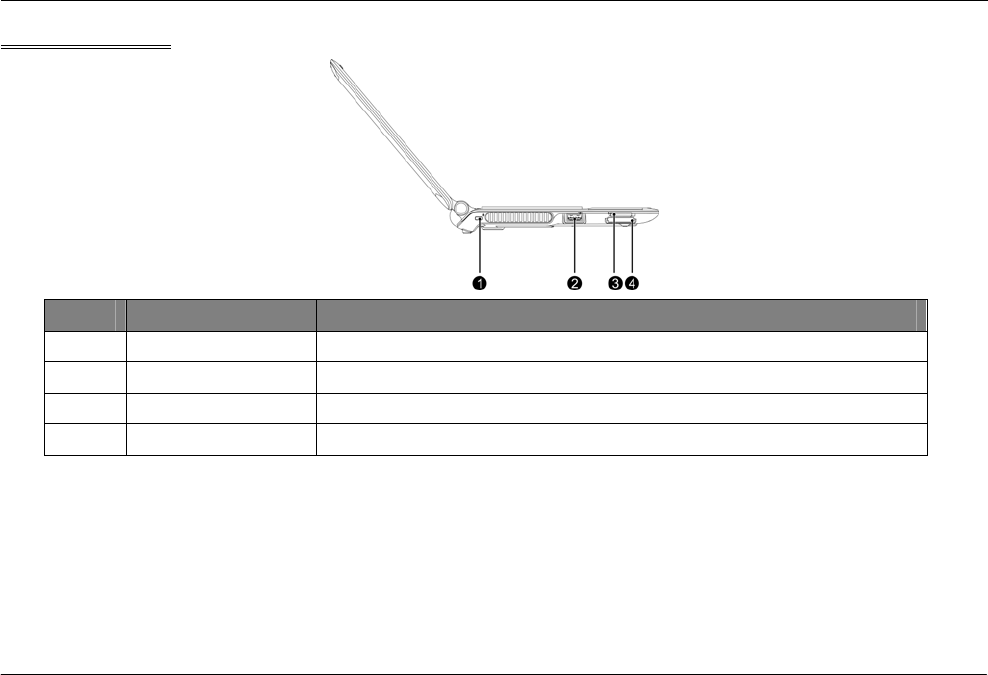
User’ Manual
Page 10 of 43
1.2 Left View
Icon Item Description
1 Kensington lock hole To connect compatible kensington lock.
2 USB port To connect peripheral equipment with USB interface.
3 SIM card slot Can support SIM card.
4 Card reader To read from SD/MMC/MMC PRO Card.
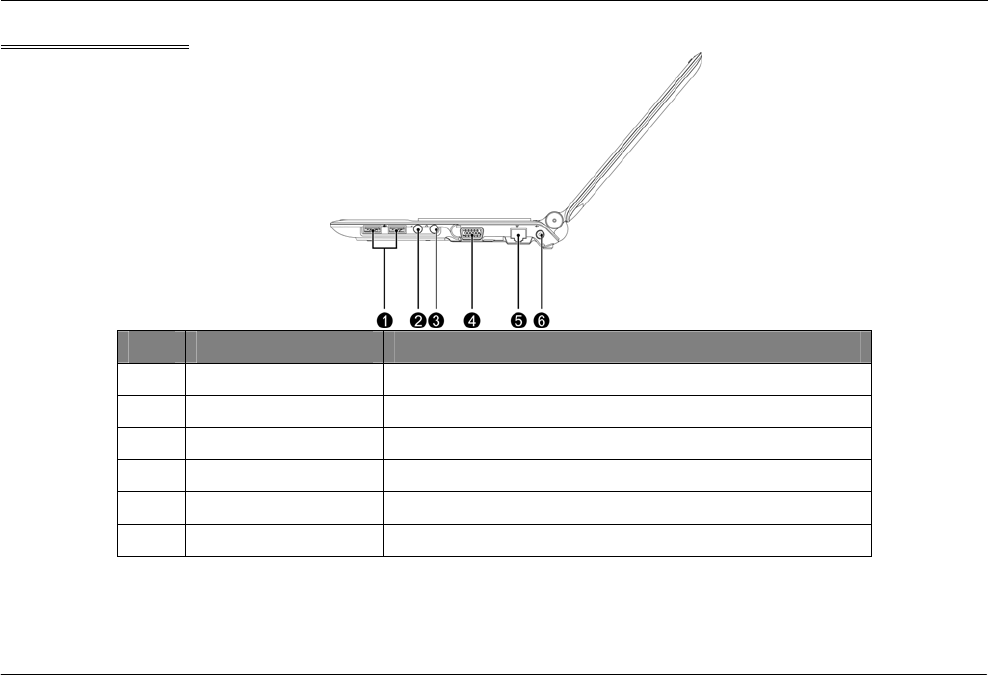
User’ Manual
Page 11 of 43
1.3 Right View
Icon Item Description
1、2USB port To connect peripheral equipment with USB interface.
3 MIC jack To connect MIC to input audio signal.
4 Stereo speaker Output sound
5 VGA Port To connect VGA monitor.
6 LAN RJ45 jack To connect LAN.
7 Power Adapter Port To connect AC Adapter
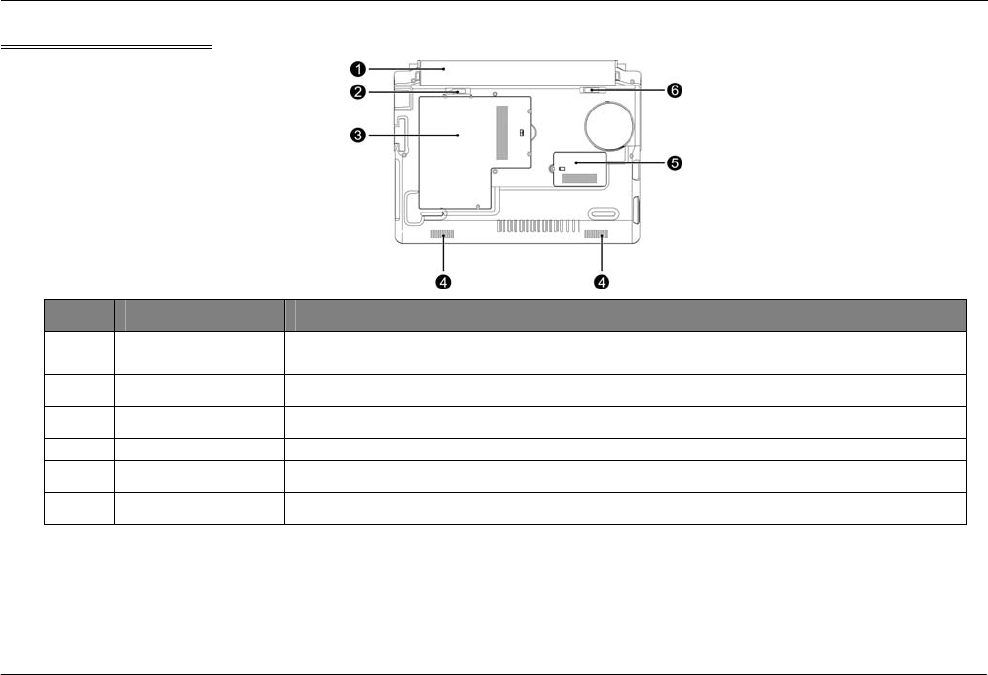
User’ Manual
Page 12 of 43
1.4 Bottom View
Icon Item Description
1 Battery Installed in the battery compartment, to supply power to the Laptop when AC power
is disconnected.
2 Battery latch To fix and lock battery.
3 HDD Cover To uninstall or change HDD.
4 Stereo speaker Output sound
5 Memory Cover To uninstall or change Memory.
6 Battery latch To fix and lock battery.
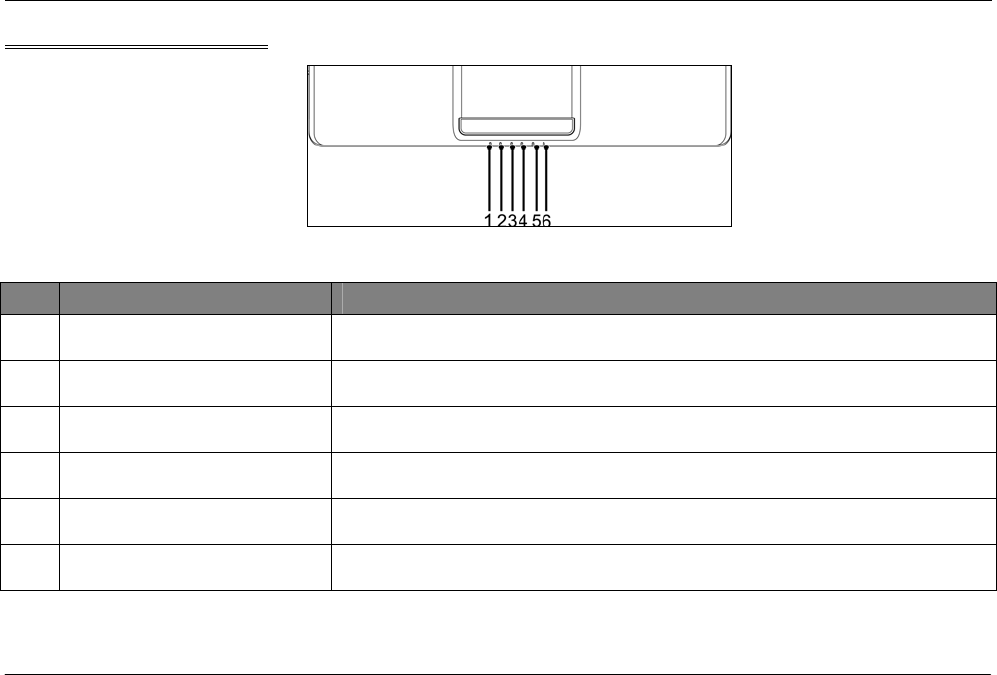
User’ Manual
Page 13 of 43
1.5 Status Indicators
Icon Item Description
1 Power indicator This light on the power button illuminates when the computer is powered on.
2 Battery indicator Green indicates fully charged. Red indicates battery is being charged. Flashing
indicates battery is running low
3 HDD Activity indicator The Hard Disk Drive (HDD) Activity indicator tells you whether your internal hard
drive is being accessed and, if so, how fast.
4 Wireless LAN Activity indicator The Wireless LAN Activity indicator tells you whether your computer is connected
to a wireless network or not.
5 Number Lock indicator This indicator states that the internal keyboard is set in ten-key numeric keypad
mode.
6 CAPS Lock indicator This indicator tells you that the keyboard is set to type in all capital letters.
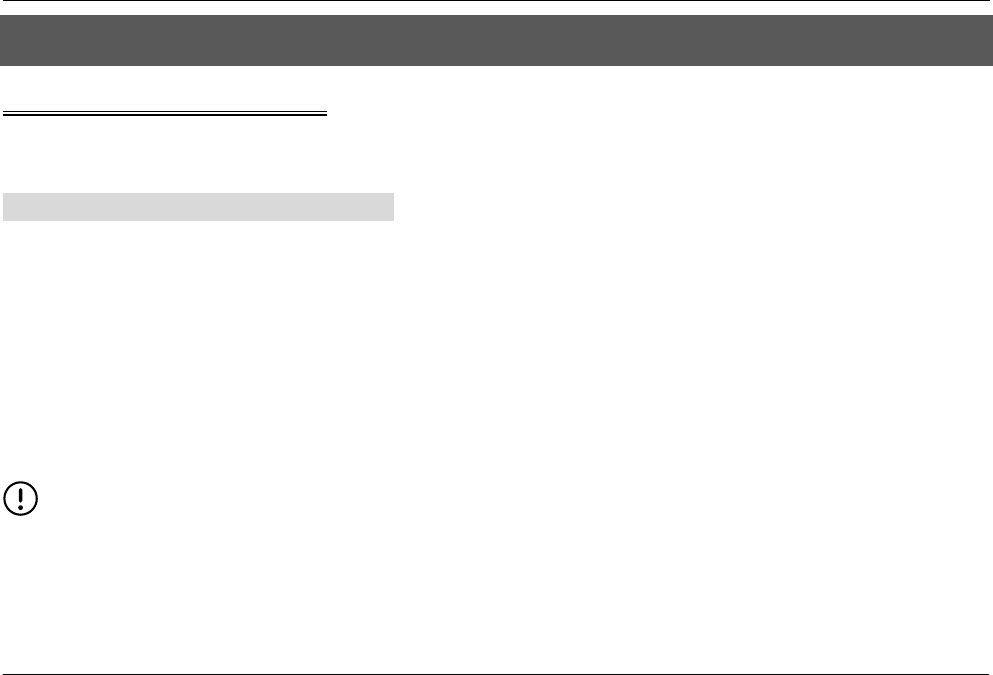
User’ Manual
Page 14 of 43
Chapter 2 Learning the Basics
2.1 Select a place to work
The Laptop is portable and designed to be used in a variety of circumstances and locations. Please refer to the following
information to use it more comfortably:
Creating Laptop-friendly environment
Place the Laptop on a flat surface that is large enough for the Laptop and any other items you need to use, such as a printer.
Leave enough space around the Laptop and other equipment in order to provide adequate ventilation and prevent
overheating.
To keep your Laptop in prime operating condition, protect your work area from:
Dust, moisture, and direct sunlight.
Equipment that generates a strong electromagnetic field, such as stereo speakers (other than speakers that are
connected to the Laptop) or speakerphones.
Rapid changes in temperature or humidity and sources of temperature change, such as air conditioner vents or heaters.
Extreme heat, cold, or humidity. The suitable ones are relative temperature between 10ºC ~ 35ºC, and relative humidity
between 20% ~ 80%.
Liquids and corrosive chemicals.
…………………
Notice: If you spill liquid into the Laptop, please turn it off immediately, unplug it from AC power source, and let it dry out
completely before turning it on again.
If the Laptop does not operate correctly after you turn it on again, please kindly contact your local dealer.

User’ Manual
Page 15 of 43
Keeping yourself comfortable
Strain and stress injuries are becoming more common as people spend more time using their Laptops. With a little care and
proper use of the equipment, you can work comfortably throughout the day.
This section provides hints on avoiding strain and stress injuries. For more information, consult books on ergonomics,
repetitive-strain injury, and repetitive-stress syndrome.
Placement of the Laptop
Proper placement of the Laptop and external devices is important to avoid stress-related injuries.
Place the Laptop on a flat surface at a comfortable height and distance.
You should be able to type without twisting your torso or neck, and look at the screen without slouching.
If you are using an external monitor, the top of the display should be no higher than eye level.
If you are using a paper holder, set it at about the same height and distance as the screen.
Seating and posture
When using your Laptop, please maintain good posture with your body relaxed and your weight distributed evenly. Proper
seating is a primary factor for reducing your work strain. Some people find a backless chair is more comfortable than a
conventional chair.
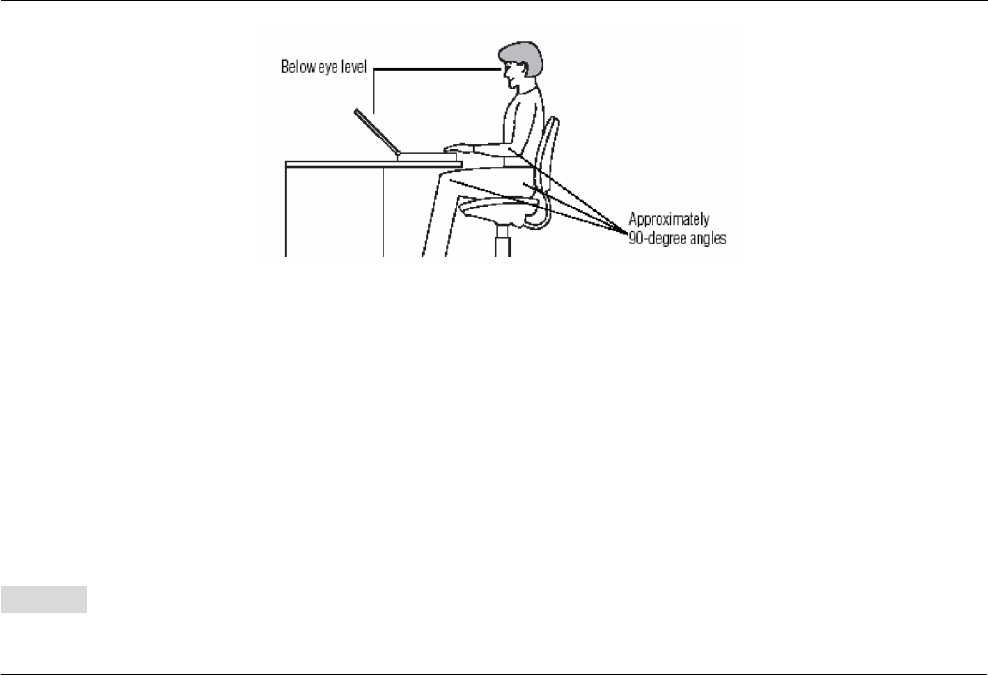
User’ Manual
Page 16 of 43
Correct positioning and posture of Laptop
Whichever type you choose, use the following guidelines to adjust your chair for maximum computing comfort:
Position your chair so that the keyboard is at or slightly below the level of your elbow. You should be able to type
comfortably with your shoulders relaxed and your forearms parallel to the floor.
If you are using a conventional chair:
Your knees should be slightly higher than your hips. If necessary, please use a footrest to raise the level of your knees
and ease the pressure on the back of your thighs.
Adjust the back of your chair so that it supports the lower curve of your spine.
If necessary, please use a cushion to provide extra back support. Lower-back-supported cushions are available at
many office supply stores.
Sit with your back straight so that your knees, hips, and elbows form approximately 90-degree angles when you are
working. DO NOT slump forward or lean back too far.
Lighting
Proper lighting can improve the visibility of the display and reduce eyestrain.

User’ Manual
Page 17 of 43
Position the display panel or external monitor to make sure sunlight or bright indoor lighting does not reflect off the
screen. Also, please use tinted windows or shades to reduce glare.
Please avoid placing your Laptop in front of a bright light that could shine directly in your eyes.
If possible, use soft, indirect lighting in your Laptop work area.
Arms and wrists
To avoid bending, arching, or twisting your wrists,please keep them in a relaxed, natural position while typing.
Exercise your hands, wrists, and arms to improve circulation.
…………………
Notice: Using the Laptop keyboard incorrectly may result in discomfort and possible injury. If your hands, wrists, and/or arms
bother you while typing, stop using the Laptop and rest. If the discomfort persists, please consult a physician.
Work habits
The key to avoid discomfort or injury from strain is to vary your activities. If possible, please schedule a variety of tasks into
your working day. Finding ways to break up the routine can reduce stress and improve your efficiency.
Take frequent breaks to change position, stretch your muscles, and relieve your eyes. A break of two or three minutes
every half-hour is more effective than a long break after several hours.
Avoid performing repetitive activities for long periods. Please intersperse such activities with other tasks.
Focusing your eyes on your Laptop screen for long periods can cause eyestrain. Look away from the Laptop frequently
and focus your eyes on a distant object for at least 30 seconds.
Precautions
Your Laptop is designed to provide optimum safety and ease of use, and to withstand the rigors of travel. You are
recommended to observe certain precautions to further reduce the risk of personal injury or damage to the Laptop.

User’ Manual
Page 18 of 43
Avoid prolonged physical contact with the underside of the Laptop. If the Laptop is used for long periods, its case may
become very warm. While the temperature may not feel too hot to the touch, if you maintain physical contact with the
Laptop for a long time (if you rest the Laptop on your lap, for example), your skin might suffer low-heat injury.
Never apply heavy pressure to the Laptop or subject it to sharp impacts. Excessive pressure or impact may damage the
Laptop components or cause your Laptop to malfunction.
Some PC Cards may become hot with prolonged use. If two cards are installed, both may become hot even if only one
is being used. Overheating of a PC Card can result in errors or instability in its operation. So please be careful when you
are removing a PC Card that has been used for a long period.
Avoid spilling liquids into the Laptop’s keyboard. If you do spill a liquid that gets into the keyboard, turn off the Laptop
immediately, then leave the Laptop turned off overnight to let it dry out before you use it again.
Never turn off the Laptop if a drive-in-use light indicates a drive is active. Turning off the Laptop while it is reading from
or writing to a disk may damage the disk, the drive, or both.
Keep the Laptop and disks away from objects that generate strong magnetic fields, such as large stereo speakers.
Information on diskettes is stored magnetically. Placing a magnet too close to a diskette can erase important files.
Scan all new files for viruses.
This precaution is especially important for files you receive via diskette, CD or DVD discs, email, or download from the
Internet. Occasionally, even new programs you buy from a supplier may contain a Laptop virus. You’ll need a special
program to check for viruses. Please ask your local dealer for help if need.
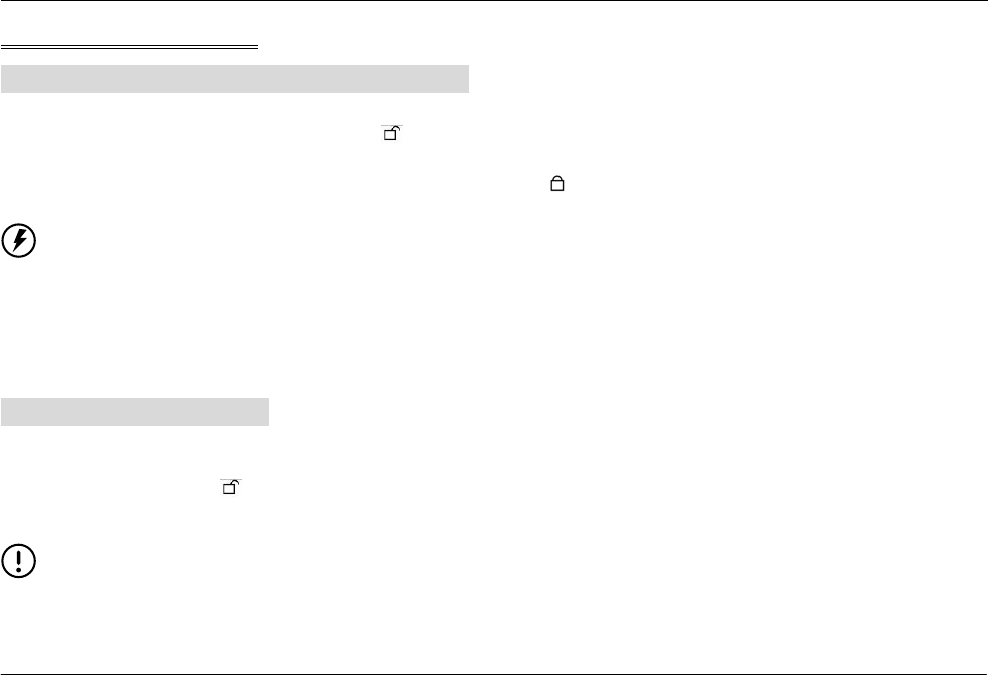
User’ Manual
Page 19 of 43
2.2 Fix battery pack
Follow the following items to fix battery pack:
Turn the Laptop upside down on the even table.
Push the battery latch to the position of 『 』.
Fix the battery pack as the big arrow shows.
After a sound of click, push the battery latch to the position of『 』.
…………………
Warning:
1)Do not disassemble the battery pack.
2)Keep the battery pack away from the metal items .
3)Keep the battery pack away from the water or lotion.
4)Keep the battery pack away from children.
Uninstall the battery pack
Follow the below items to uninstall the battery pack:
1. Be sure the Laptop is turned off. Turn the Laptop upside down.
2. Release the latch to『』,the battery pack will pop up a little.
3. Take off the battery pack.
…………………
Notice: If you want to use your Laptop, please connect it to AC electricity power before uninstalling battery pack.
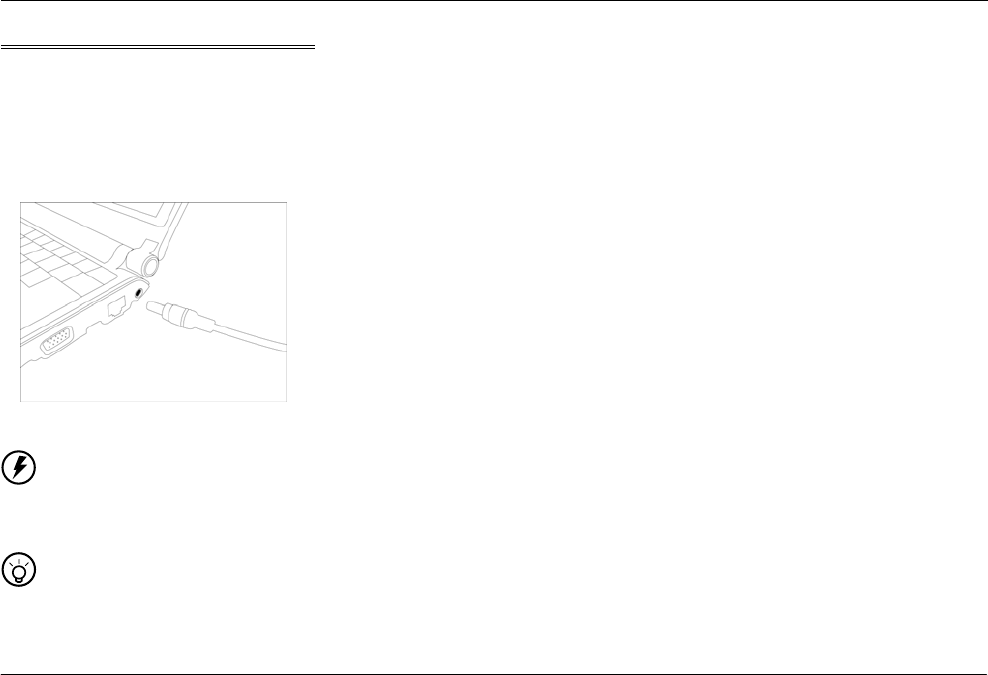
User’ Manual
Page 20 of 43
2.3 Connect AC Adapter
The AC adapter enables you to power the Laptop from an AC outlet and to charge the Laptop’s battery pack. The AC power
light on the Laptop glows when the device is plugged in.
To connect AC power to the Laptop, you should:
1. Plug AC adapter into the DC-in on the right side of the Laptop.
2. Connect the power cable to AC adapter.
3. Connect the power cable to a live electrical outlet.
The picture showed here may be different from the exact outlook of the Laptop due to different style of our product. Please
consider the outlook showed by the Laptop as standard.
…………………
Warning: The AC adapter is special for the Great Wall certain Laptop Model. Please do not use it to other equipments; or do
not use other AC adapter to the Laptop.
…………………
Tips: Please take outlet switch to matcher your Laptop’s power cord if you travel to different country or area.
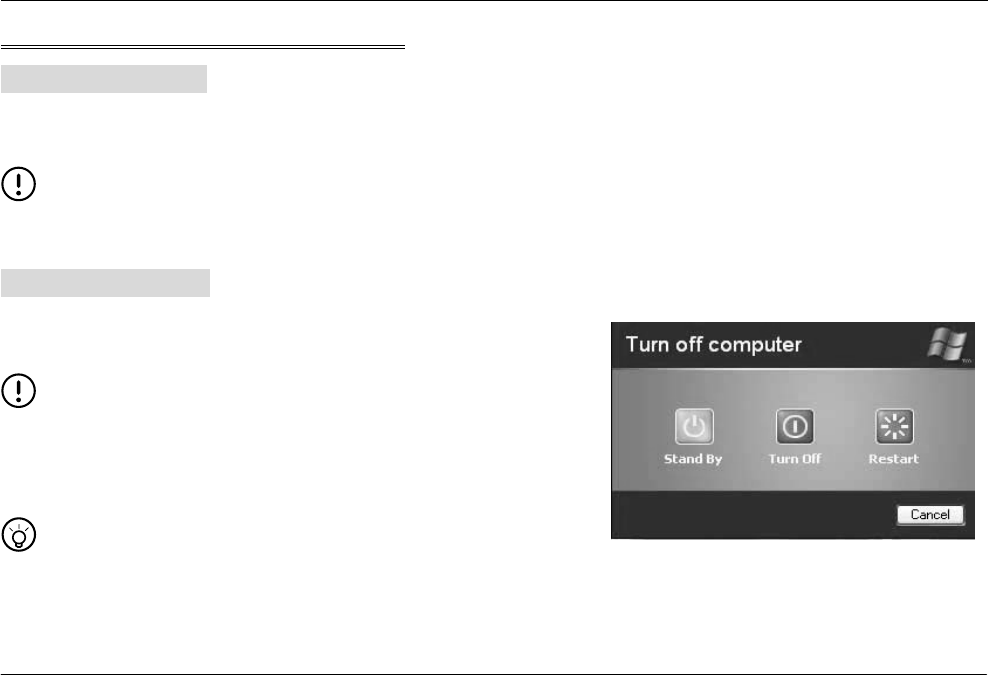
User’ Manual
Page 21 of 43
2.4 Turn on/turn off the Laptop
Turn on the Laptop
After the Laptop is powered and the LCD is opened to a suitable angle, you can press the power key to turn on the Laptop.
Press the power button about one second to turn on the Laptop.
…………………
In the event the system can not be turned off in the above way, you can hold the power key about four seconds to turn off the
Laptop. But in this way, you may lose your data which has not been saved before you do so.
Turn off the Laptop
Your can turn off the system at Windows menu:
Click “Start”,then “Turn off ” select “Turn off ” to turn off the Laptop.
…………………
Notice: In the event the system can not be turned off in the above way, you
can hold the power key about four seconds to turn off the Laptop. But in
this way, you may lose your data which has not been saved before you do
so.
…………………
Tips: The operation described in this chapter only works under Windows®XP for other operation system, please refer to
respective help documents.
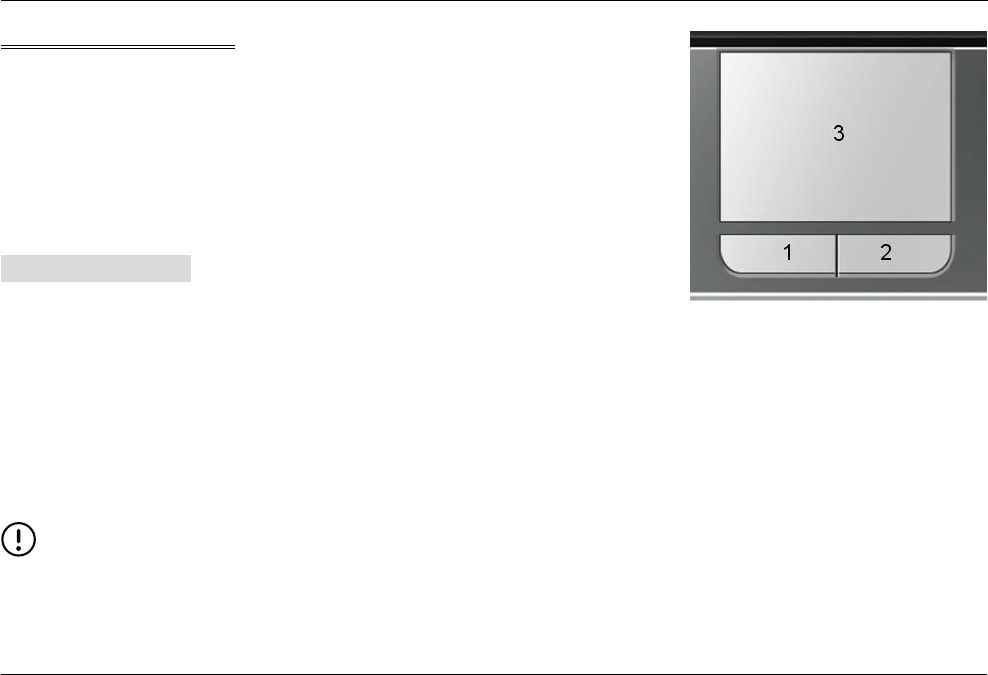
User’ Manual
Page 22 of 43
2.5 Use Touch pad
The built-in touch pad is a PS/2-compatible pointing devise that senses movement
on its surface. This means that cursor responds as you move your finger on the
surface of the touchpad. The central location on the palm rest provides optimum
comfort and support.
The picture showed here may be different from the exact touch pad outlook of the
Laptop due to different style of touch pad. Please consider the touch pad outlook
showed by the Laptop as standard.
Touchpad function
Here how to use the Touch Pad pointing device:
1. The rectangular surface acts like a miniature duplicate of your display screen.
To move the mouse cursor, place the finger lightly on the sensor pad and
move in the desired direction. If you reach the end of the pad, lift your finger
and place it back down on the other side of the pad.
2. To select an item, click on the item by pressing the left button control or by simply tapping on the surface once. A light,
quick tap always works best. To execute an item, click the left button twice or do a quick double tap on the surface.
3. To simulate holding the mouse button down (dragging an icon or selection), use the tap-and-drag gesture. This feels
much like a double-click, except that the finger remains on the pad after the second tap: Tap, lift, tap, hold and move.
The simulated button remains held as long as the finger remains on the pad.
…………………
Notice: Keep your fingers dry
Pad dry and clean. Thus the touch pad can be sensitive enough to finger movement. Hence the lighter the touch is, the better
the response is. Tapping too hard will not improve the touch pad responsiveness.
1. left Selection Button
2. right Selection Button
3. touchpad
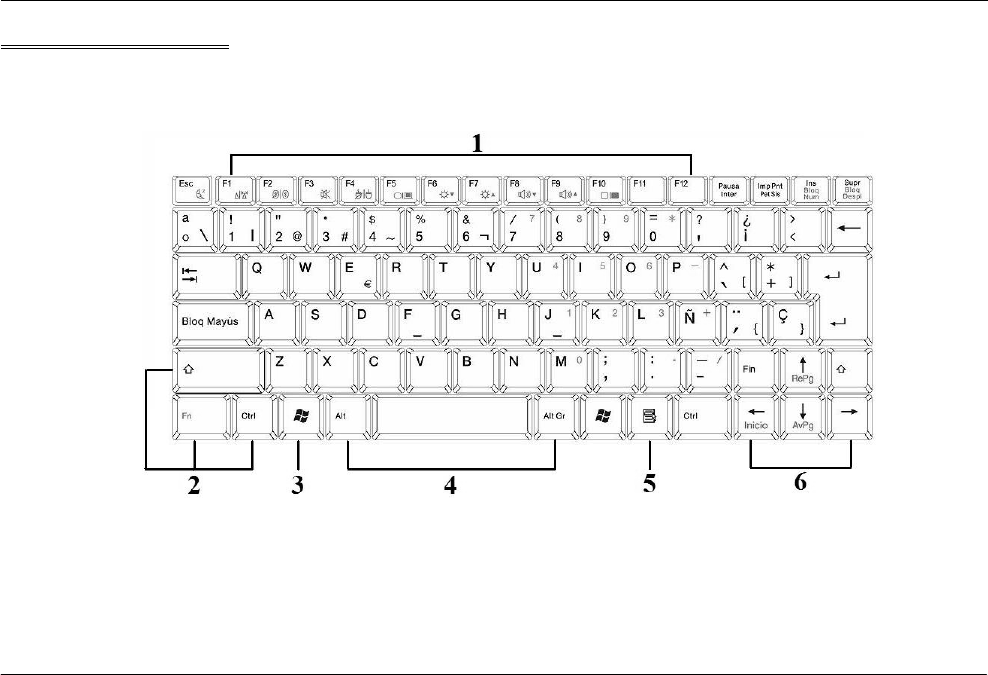
User’ Manual
Page 23 of 43
2.6 Use Keyboard
Your laptop computer is equipped with an 87 keys keyboard that provides all the functionality of a full-sized 101 or 102-key
keyboard. Aside from the standard typewriter-layout keyboard of your computer, there are a number of extra features and
function controls on the built-in keyboard including Windows system hot keys.
1. Function Keys 2. Control Keys
3. Windows Start Menu Key 4. Control Keys
5. Windows Shortcut Key 6. Cursor Control Keys

User’ Manual
Page 24 of 43
Key features and operations are described below:
Function Keys
Function keys are application-driven, like F1 through F12 can be found on the keyboard. These keys work together with the
Fn key to activate special functions. Some keys (printed in blue on keypad) are preprogrammed with dual functions.
Control keys — Ctrl, Alt, Fn, and Shift are controls used in conjunction with other keys to change their
functions. To use control keys, press and hold the control key while pressing another key. For example,
"Press Ctrl-C" means to hold down the Ctrl key and type the letter C. Key combinations work
especially to the application you are running.
Windows keys
Use the following two keys to facilitate your work:
Start Menu key: Displays the Start menu.
Shortcut/Application key: Provides quick access to shortcut menus. This key acts like a right mouse button.
Cursor Control keys
Cursor control keys let you position the cursor on the screen where you want. In the screen, the cursor is a blinking underline,
block, or vertical bar depending on the application. The cursor indicates where the next text typed is inserted.
Typewriter keys
Typewriter keys (also called alphanumeric keys) are used to enter text and characters. Keys with blue print on them behave
differently when combined with control keys.
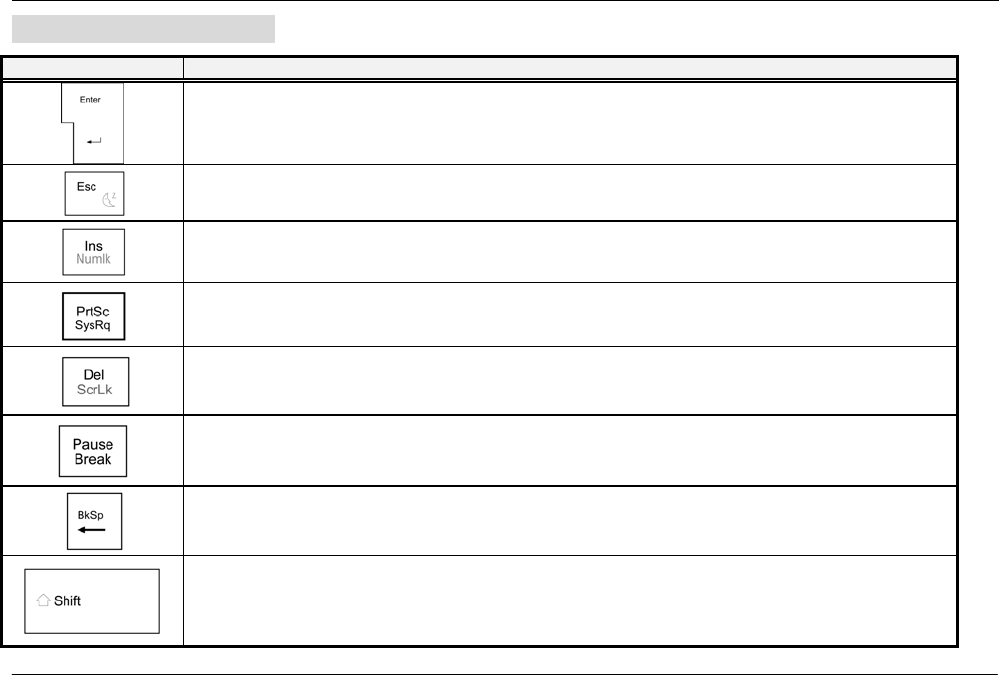
User’ Manual
Page 25 of 43
Basic Keyboard Functions
Keypad Function Description
<Enter> key. Execute a command. Within many text editing application programs, the <Enter>
key inserts a hard carriage return, just like what ordinary typewriter does.
<Esc> key. Press this key to cancel or escape from a command or function.
<Ins> key. Known as the Insert key. Press this key to toggle the keyboard data entry from insert
to type over mode.
<PrtScr> key. Known as the Print Screen key. Press this key to map the whole screen to share
memory for your specific usage.
<Del> key. Known as the Delete key. Press this key to delete the character to the right of the
cursor, or delete marked texts or items.
<Pause> key. Press this key to temporarily halt execution of a command. Pressing any other
key to resume execution of a command.
<Backspace> key. Press this key to delete the character to the left of the cursor.
<Shift> key. Press this key in combination with alphabet letters to produce uppercase letters in
typing. Use this key in combination with those two-character keys (found on the second row of
the keyboard) to produce the upper marked keys. Also used in most application program in
combination with other keys to execute a certain command.
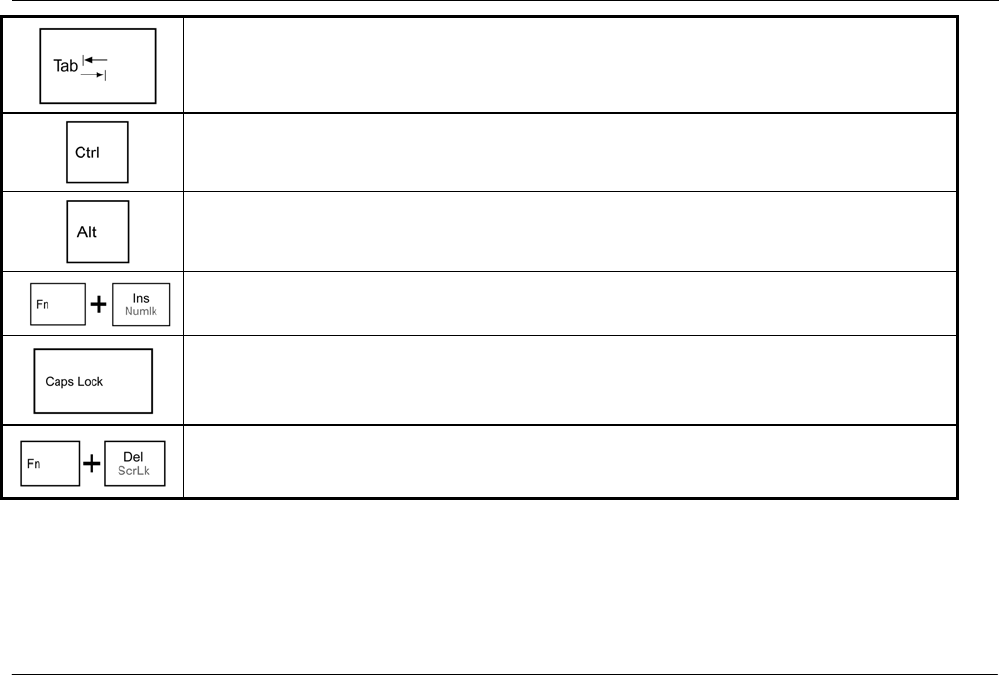
User’ Manual
Page 26 of 43
<Tab> key. Press this key to move the cursor to the next tab stop on the right. This key works
much the same as in ordinary typewriter.
<Ctrl> key. Known as the Control key. Used in most application program in combination with
other keys to execute a certain command.
<Alt> key. Known as the Alternate key. Used in most application program in combination with
other keys to execute a certain command.
<Fn> + <Num Lock> key. Activates the embedded 15-key numeric keypad. The keys are color
coded blue.
<Caps Lock> key. Used in most application program to always activate uppercase alphabet
characters.
<Fn> + <Scroll Lock> key. Used in most application program to scroll the screen without having
to move the cursor.
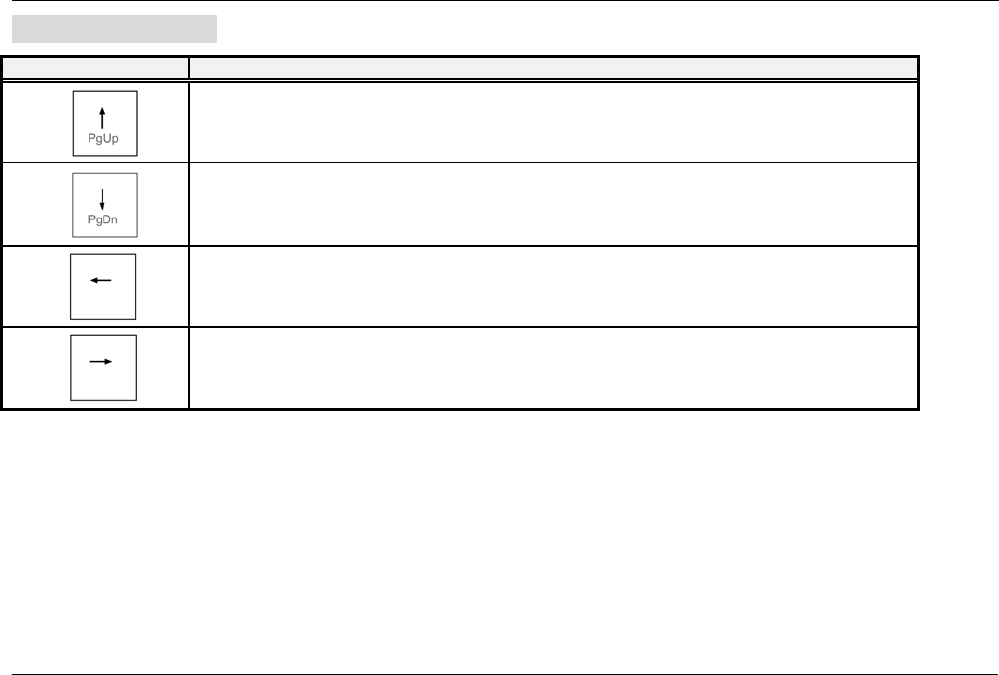
User’ Manual
Page 27 of 43
Cursor Control Keys
Keypad Function Description
Up arrow key. Moves the cursor up one line at a time.
Down arrow key. Moves the cursor down one line at a time.
Left arrow key. Moves the cursor to the left one space at a time.
Right arrow key. Moves the cursor to the right one space at a time.
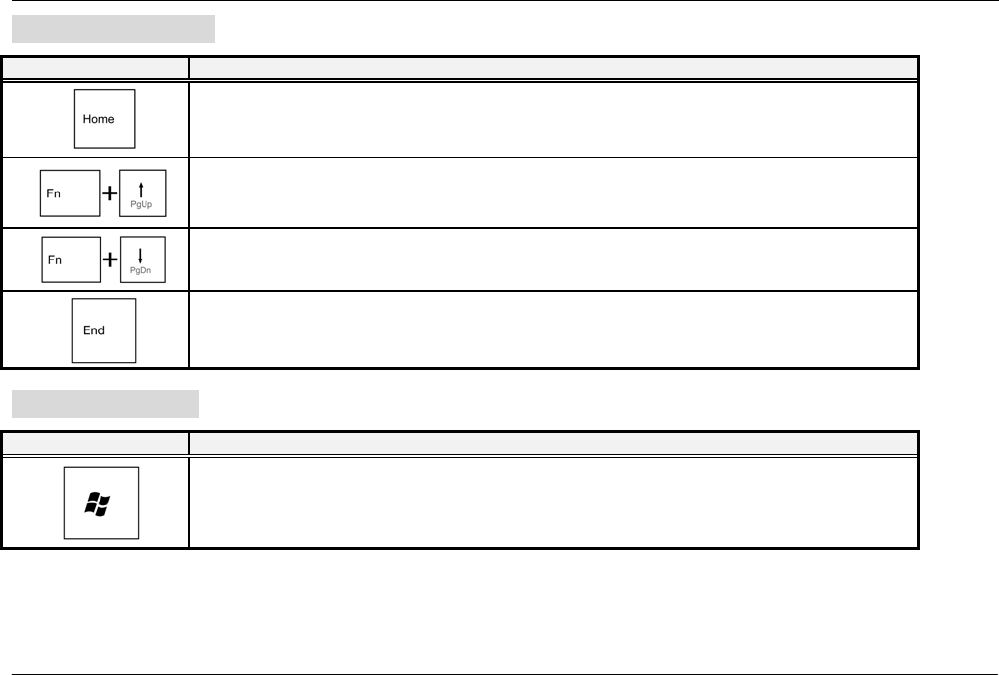
User’ Manual
Page 28 of 43
Screen Control Keys
Keypad Function Description
<Home> key. Moves the cursor to the beginning of a screen or line.
<Fn>+<PgUp> key. Moves the cursor up one screen at a time
<Fn>+<PgDn> key. Moves the cursor down one screen at a time
<End> key. Moves the cursor to the end of a screen or line.
Windows Hot Keys
Keypad Function Description
<Start> key. Pulls up the Windows Start menu.
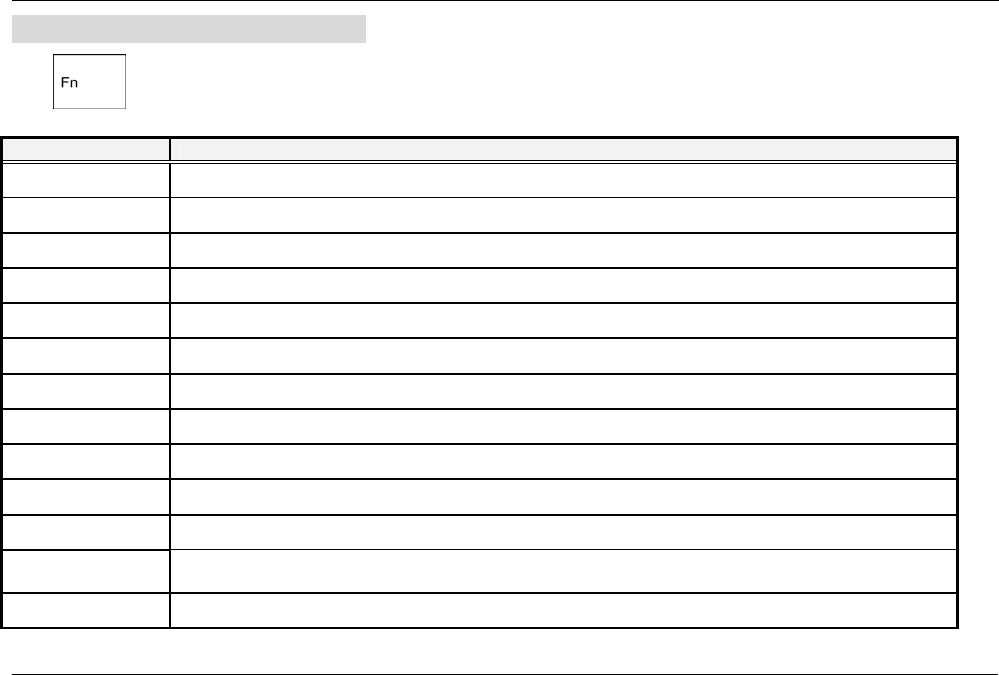
User’ Manual
Page 29 of 43
Fn Combination Keys (Hot Keys)
Use Fn key combined with other keys to activate, close or set special functions. These combinations are also
called Hot Keys. To use the Hot Keys, press and hold down <Fn> together with the keys described below。
Keypad Function Description
Fn+Esc Places the notebook in Suspend mode. Pressing the Power button returns it to active mode.
Fn+F1 Enables or disables the wireless network connection
Fn+F2 Enables or disables the Bluetooth connection(Option)
Fn+F3 Mutes the computer's volume
Fn+F4 Enables or disables the TouchPad
Fn+F5 Switch displays. Depending on presence of external display
Fn+F6 Decrease Screen brightness
Fn+F7 Increase Screen brightness
Fn+F8 Decreases the computer's volume.
Fn+F9 Increases the computer's volume.
Fn+F10 Toggle the LCD display on and off
Fn+Ins Press this key to turn on the numeric keypad overlay, The numeric mode keyboard indicator light
glows when the numeric overlay is on.
Fn+Del Press this key to scroll the screen under some programs.
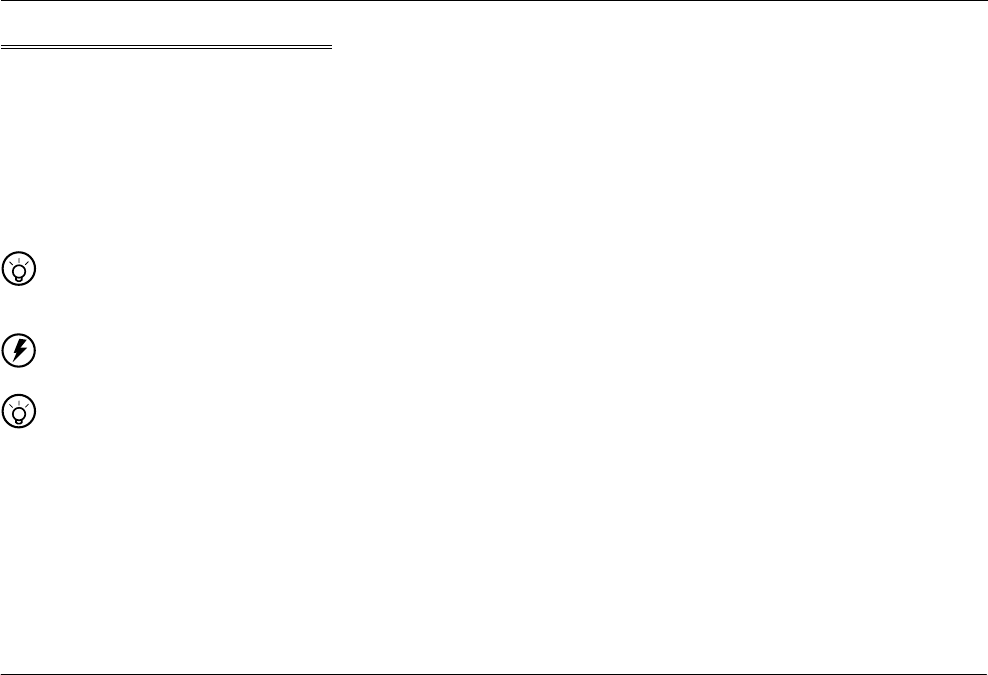
User’ Manual
Page 30 of 43
2.7 Carrying your Laptop
Your Laptop is durable and stable. But it will be good for your Laptop if some cautions as following are adopted when you are
moving the Laptop:
Check the indicators of the built-in hard disk and disk driver to make sure all the disks are stopped working.
Power off the Laptop.
Disconnect all the peripheral equipments before moving the Laptop.
Disconnect AC adapter before moving the Laptop.
DO NOT carry your Laptop by LCD panel or the rear part of the Laptop.
Please use the packaged bag to carry your Laptop.
…………………
Tips: You can keep your Laptop in Hibernation mode to save your working status on the Laptop if you will carry the Laptop to
a meeting. In this way, when you open the Laptop next time, the original status will be showed to you.
…………………
Warning: Do not move your Laptop when the HDD or ODD is running.
…………………
Tips: Please check whether your power cord matches the local power supply or not if you will travel to other county/area or
not.
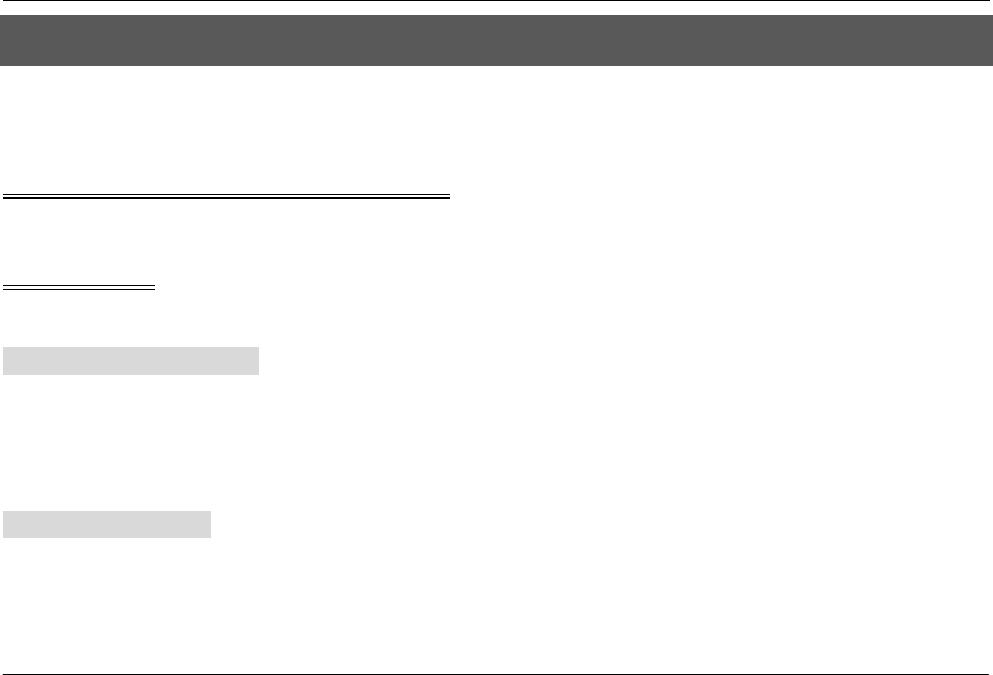
User’ Manual
Page 31 of 43
Chapter 3 BIOS Setup Utility
The BIOS Setup Utility is a hardware configuration program built into your Laptop’ BIOS (basic input/output system). Your
Laptop is already properly configured and optimized, and you do not need to run this utility. However, if you encounter
configuration problems, you may need to run it.
3.1 Activate the BIOS Setup Utility
To activate the BIOS Setup Utility, press F2 or Del during POST.
3.2 Security
The Security screen contains parameters that help safeguard and protect your Laptop from unauthorized use.
Set Supervisor Password
With this setting, only authorized user can enter the system. Follow the below to set:
Select menu Security.
Select “Set Supervisor Password” and then press “Enter”.
Input the desired password twice.
Press “Enter”, when box of Setup Notice shows password information.
Set User Password
It’s always the same to set user passport as that of supervisor password. But the former can only enter OS, not BIOS Setup.

User’ Manual
Page 32 of 43
3.3 Set Boot priority order
With this setting, you can set the order of booting the hardware of the Laptop.(please refer the quick help)
3.4 Recover original settings
In the exit from the BIOS Setup Utility, you can return to original settings by “Load Setup Defaults” or press “F9”.
3.5 Tips & Notice
1. For more information about Menu and Keys, please refer to the help information of respective selection. There may be
difference of BIOS setting between different versions of BIOS of different batch of laptops produced.
2. The BIOS of your Laptop has been initialized to best settings. It’s advised you not to change it if not so necessary.
3. Do not lose the password of your system. In the event of this, you should have to refer to the service center of your
Laptop.
4. If you change the BIOS settings and can not return to original settings, you can return to original settings by “Load Setup
Defaults”.
Discard Changes:User can discard current settings and return to last settings.
Save Changes:User can save the settings but will not exit the BIOS setting menu.
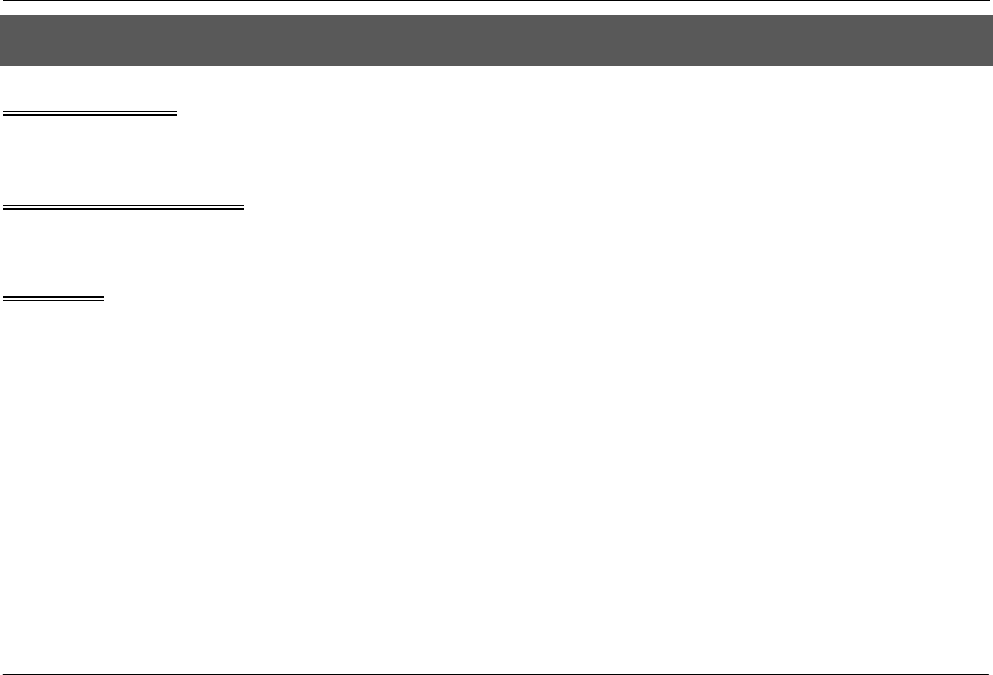
User’ Manual
Page 33 of 43
Chapter 4 Install drivers
4.1 Install OS
Please take the OS CD in your external ODD driver,install the OS to your Laptop by flow the OS handle manual.
4.2 Install drivers
The drivers DISC will run automatically when it is inserted to Laptop’s optical DISC driver.
4.3 Tips
The pictures showed at this chapter may be different from those showed by your Laptop due to different versions of drivers.
Please set pictures of your Laptop as standard.
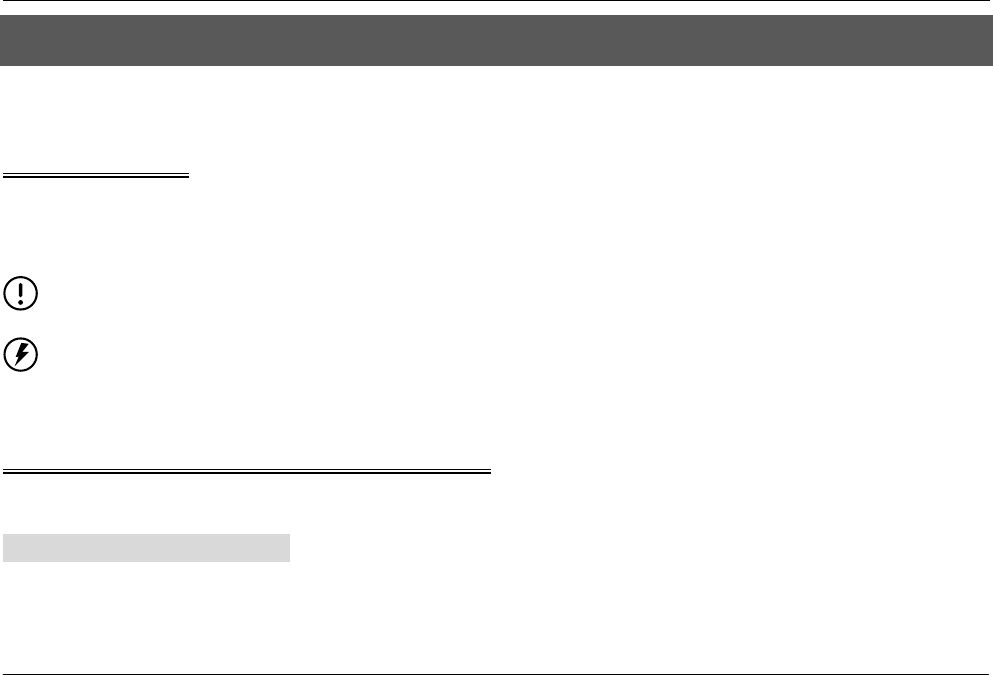
User’ Manual
Page 34 of 43
Chapter 5 Power Management
Power Supply of the Laptop is introduced in this chapter. The power supplied to the Laptop comes from the power converted
by AC Adapter from alternative currency or battery pack.
5.1 Ac adapter
The power supplied to the Laptop comes from the power by AC Adapter is used to convert alternative currency to direct
currency to power the Laptop. Insert the plug of adapter into the electricity socket, and then the indicator of the power will
light up.
…………………
Notice: Please read “Taking care of your AC adapter” before using.
…………………
Warning: There are high-voltage components in adapter. To avoid injury to your body, DO NOT disassemble adapter and
repair it.
5.2 Lithium Ion ( Li-Ion) battery pack
Your Laptop uses one battery pack that gives you long use between charges.
Battery pack characteristics
The battery pack has the following characteristics
Employ current battery technology standards
Battery-low warning

User’ Manual
Page 35 of 43
Whenever possible, use the AC adapter. The battery will come in handy when you travel or during a power failure. It is
advisable to have an extra fully-charged battery pack available as backup. Contact your dealer for more details.
Maximizing battery life
Laptop batteries, like all other batteries, are “consumables”. This means that their use is consumed over a period of time, and
that their performance diminishes over this lifecycle. In order to maximize the length of your battery’s life, please read and
adhere to the recommendations set out below.
Conditioning a new battery pack
When using a battery pack for the first time, there is a “conditioning” process that should be followed first before using it with
your Laptop.
Insert the battery into the Laptop. Do not turn the Laptop on.
Connect the AC adapter to a power source (i.e., a power outlet) and to the Laptop and fully recharge the battery.
Disconnect the adapter from the power source.
Use the Laptop on battery power. Do not plug in AC power during this initial use period.
Once the battery is fully depleted of charge while being used (i.e., the Laptop warns you to “switch to AC power”), turn
the Laptop off and follow step 1 again.
…………………
Notice: Repeat these steps two times. Total conditioning process is 3 charges/ discharges.
Use this process with a new battery or with a battery that's been stored without being used for a long time. If the Laptop is to
be stored for more than two weeks, we suggest you remove the battery pack.
…………………
Warning
:
Do not expose battery packs to temperatures below 0ºC (32ºF) or above 50ºC (122ºF). This may adversely

User’ Manual
Page 36 of 43
affect the battery pack.
By following this process you will have conditioned your battery to accept the maximum charge possible. Failure to follow this
procedure will not allow you to get the longest possible battery charge from your battery and will also shorten the effective
lifespan of your battery.
The useful life span of the battery is adversely affected by the following usage patterns:
Using the Laptop on constant AC power, while the battery is inserted in the Laptop. If you are to use the Laptop on AC
power constantly, please remove the battery from the unit after it is fully charged.
Not discharging/recharging the battery to its extremes as explained in "Conditioning a new battery pack" above.
Frequency of use (the more you use the battery, the faster it will reach the end of its effective life cycle). A standard
Laptop battery has a life span of about 500 charges.
Charging the battery
To charge the battery, slide the battery pack into the battery bay and plug the AC adapter into the Laptop and an electrical
outlet.
Charging modes
The adapter has two charging modes:
Rapid mode
The Laptop uses rapid charging when power is turned off and a powered AC adapter is connected to it. In rapid mode, a fully
depleted battery gets fully charged in approximately 3 hours.
Charge-in-use mode
When the Laptop is in use with the AC adapter plugged in, the Laptop also charges the battery pack if installed. This mode
will take longer to fully charge a battery than rapid mode. In charge-in-use mode, a fully depleted battery gets fully charged in
approximately 4.5 hours.
…………………

User’ Manual
Page 37 of 43
Tips: We suggest that you charge the battery pack before retiring for the day, letting it charge overnight before traveling. This
ensures a fully charged battery for use the next day.
Checking the battery level
Using the Windows battery meter:
The Windows battery meter indicates the present battery level. Simply rest your cursor on the battery meter (or AC plug) icon
on the taskbar to see the present charge level of your battery.
Optimizing battery life
This section helps you get the most out of battery operation. Optimizing battery life prolongs the charge/recharge cycle and
improves recharge efficiency. Follow these suggestions to optimize and maximize battery power:
Purchase an extra battery pack.
Use the AC adapter whenever possible so that the battery is reserved for on-the-go computing.
Keep the battery pack in the Laptop powered by the AC adapter. The constant trickle charge maintains the battery level
to eliminate the battery self-discharge effect. The charge-in-use function also charges the battery pack.
Disable the parallel port if no devices are connected to this port. You can do this through the BIOS Setup Utility.
Eject the PC Card from the slot when it is not in use, since the PC Card draws extra power.
Store the battery pack in a cool, dry place. The recommended storage temperature for battery packs ranges from 10 to
30 degrees centigrade. The higher the storage temperature, the faster the battery pack self-discharges.
The batteries can be recharged about 300 times when used as directed. Excessive recharging decreases battery life.
Take care of your battery pack and AC adapter. See “Taking care of your Laptop”.
Battery-low warning
You never need to worry about battery power as long as you are using the AC adapter. However, when you operate the
Laptop on battery power, pay extra attention to the battery gauge on the status LCD.
…………………
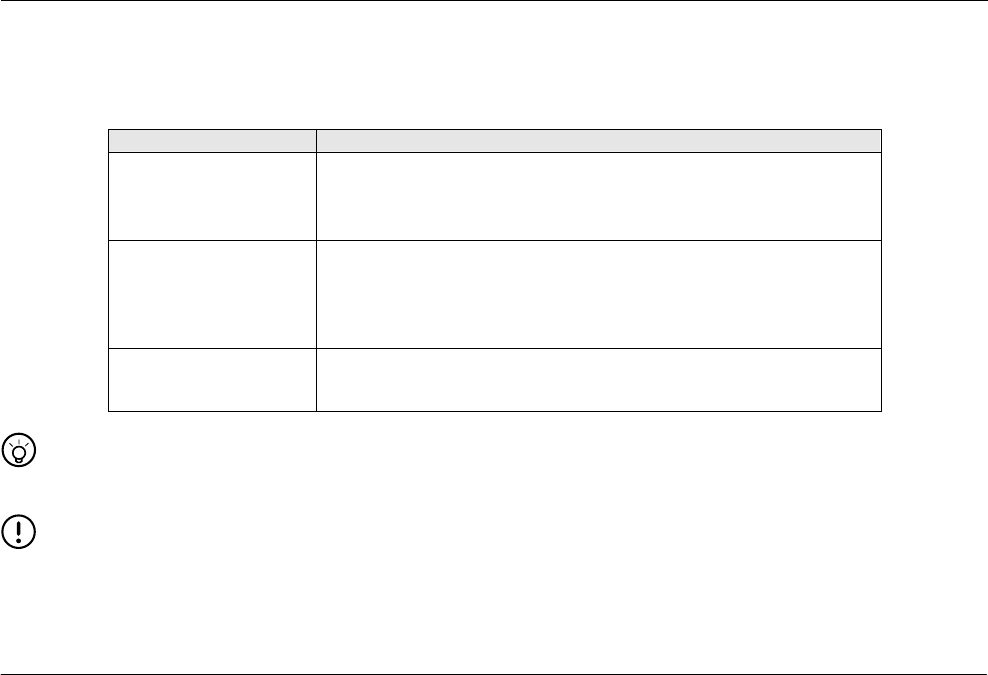
User’ Manual
Page 38 of 43
Warning! Connect the AC adapter to the Laptop as soon as possible. Data is lost when Laptop power is cut off during
Standby mode.
Table below shows the recommended course of action to take when you encounter a battery-low condition.
Situation Recommended Action
AC adapter and power
outlet available Connect the AC adapter to the Laptop.
Save all necessary files.
Resume work.
Power off the Laptop before recharging the battery rapidly.
An extra fully-charged
battery pack available
Save all necessary files.
Exit the application.
Power off the Laptop.
Replace the battery pack.
Power on the Laptop and resume work.
AC adapter or power
outlet not available Save all necessary files.
Exit the application.
Power off the Laptop.
…………………
Tips: You can use your Laptop during charging it. The charging time will be shorter if you turn off your Laptop to charge it.
…………………
Notice: Please read “Taking care your battery pack” before charging it.

User’ Manual
Page 39 of 43
5.3 Power management
This Laptop has a built-in power management unit that monitors system activity. System activity refers to any activity
involving one or more of the following devices: keyboard, mouse, floppy drive, hard disk, peripherals connected to the serial
and parallel ports, and video memory. If no activity is detected for a period of time (called an inactivity timeout), the Laptop
stops some or all of these devices in order to conserve energy.
This Laptop employs a power management scheme that supports ACPI (Advanced Configuration and Power Interface)
which allows for maximum power conservation and maximum performance at the same time. ACPI enables Windows to
control the amount of power given to each device attached to the Laptop. Windows handles all power-saving chores for your
Laptop. For more information, please refer to Windows help.
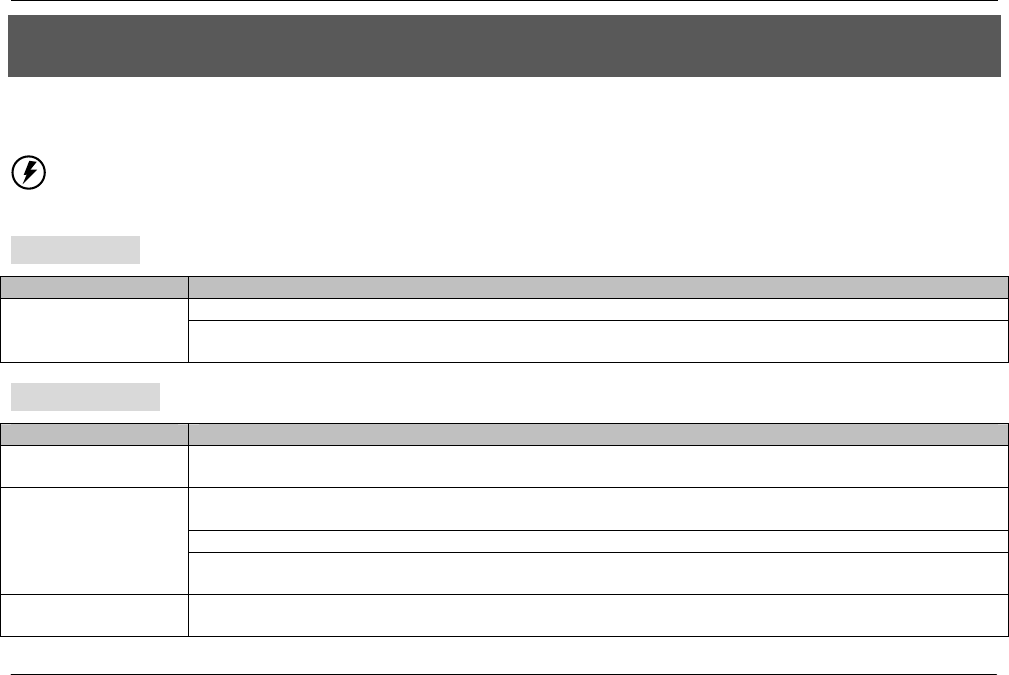
User’ Manual
Page 40 of 43
Chapter 6 Troubleshooting
This chapter contains advice and solutions to a few basic troubles you might encounter when you use the Laptop. Please
refer to this chapter and follow the instructions to solve troubles.
…………………
Warning: Under the condition that you can’t handle trouble, please refer to your dealer to get professional service.
AC Adapter
Trouble Solution
Make sure the AC adapter is well connected to the power source and the Laptop.
No power supplies
to the Laptop Check the cable and plug to make sure they are OK. If they are broken, please contact your local
dealer ASAP.
Battery pack
Trouble Solution
No power supplies
to the Laptop The remaining power in battery pack may be not enough to power on the Laptop. Connect AC
Adapter to recharge it.
Check temperature of battery pack’s surface. Battery pack can’t be recharged if its temperature is too
high or too low. Recharged it after its temperature is the same with the normal environment one.
If battery pack is fully discharged, it won’t be recharged at once. Please wait for some minutes.
Can’t be recharged
after connecting AC
Adapter If the power indicators of battery pack are always not lit up, its life may be over. Please contact your
dealer to buy another one.
Battery life is not as
long as it should be Battery life depends on using condition of the Laptop. You can change the settings in Power Manager
of OS to save power.
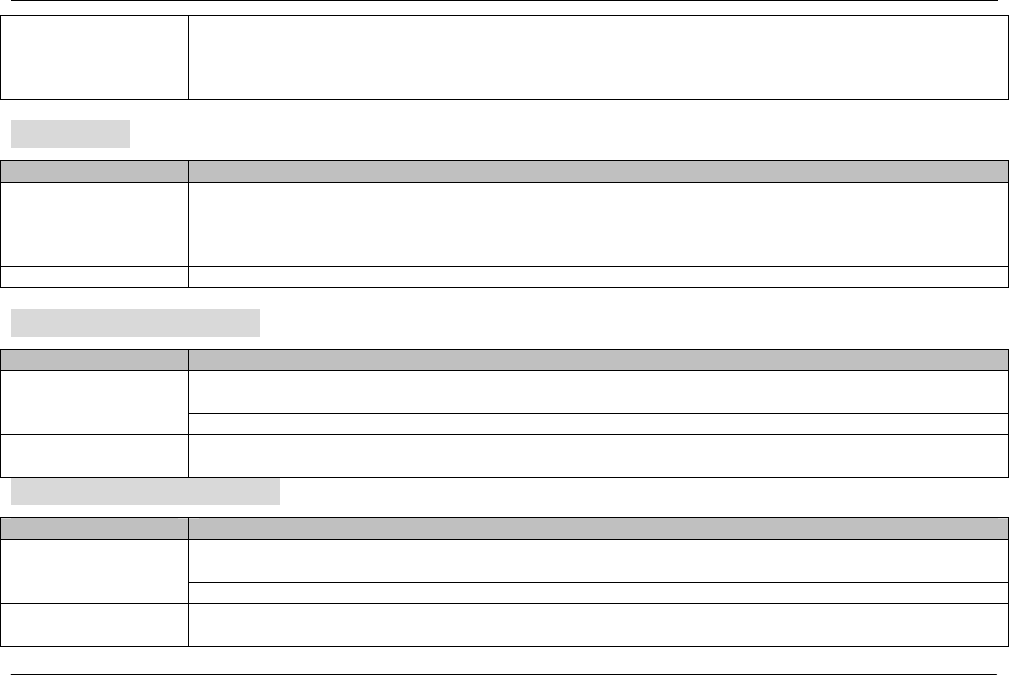
User’ Manual
Page 41 of 43
Battery pack can’t exert its full capacity if it works when not fully recharged frequently. Power the
Laptop by battery pack until its power drops to a critically low level and the Laptop emits a
high-pitched beep or displays a warning message; after that, recharge battery pack to make battery
pack work longer.
Keyboard
Trouble Solution
Press character
keys but number
displayed instead of
character
Check if Num Lock is activated. Press Fn + Num Lock and make sure the indicator of Num LK key
isn’t on.
Confusing display Make sure there is not certain software to configure to the keyboard.
Hard disc driver (HDD)
Trouble Solution
Operating system was corrupted by incorrect operating or virus. Try to clean virus and then configure
your operating system correctly.
HDD can’t be booted The documents of your OS maybe run in error, please refer to the manual of your OS.
HDD performs very
slowly There is too much file fragment. Use disk defrag tools to rearrange the programs on the hard disk.
Optical disc driver (HDD)
Trouble Solution
The disk may be dirty. Clean it with a soft damp cloth. Avoid cleaning the disk in a circular way. The
disk should be wiped in a radial direction, that is, from the inner side outward.
Can't read from
CD-ROM disk The laser lens may have become cloudy or blocked by particulate objects. Please do some cleaning.
Some disks can't be
read Make sure the configuration of software and hardware is set correctly to support your ODD.
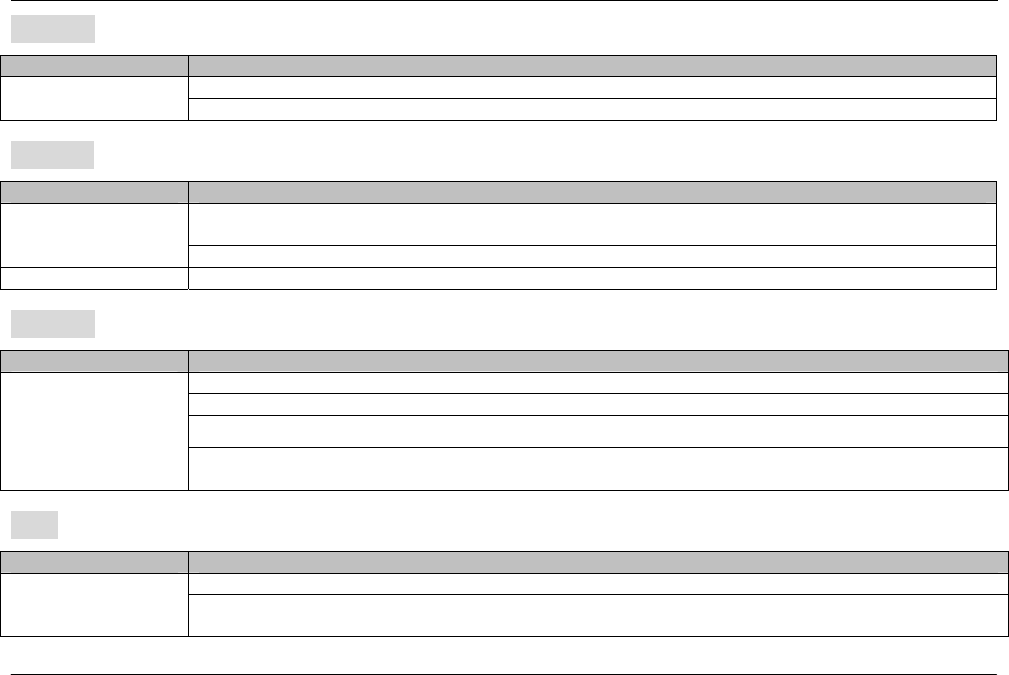
User’ Manual
Page 42 of 43
LCD
Trouble Solution
Press hot key Fn + F5 to change the display mode if certain external monitor is connected.
The screen is blank Make sure the system isn’t in the mode of Hibernation or Standby.
Printer
Trouble Solution
Make sure printer is powered on.
Make sure its cable is OK and its USB interface is well connected to the Laptop.
The data can’t be
output from the
Laptop to printer Make sure your printer is compatible to your Laptop.
Error printing Please refer to the user’s manual of your printer for help.
Audio
Trouble Solution
Adjust sound controller.
Check the setting of sound volume of software.
Check if the ear phone is firmly connected.。
No sound emitted
Check the Devices Manager of Windows. Be sure the Sound function has been activated and isn’t
interfered with other hardware.
USB
Trouble Solution
Check and be sure USB port of the Laptop is firmly connected with the USB cord of the equipment. Equipments
connected can’t
work Be sure the driver of the equipment is installed correctly.
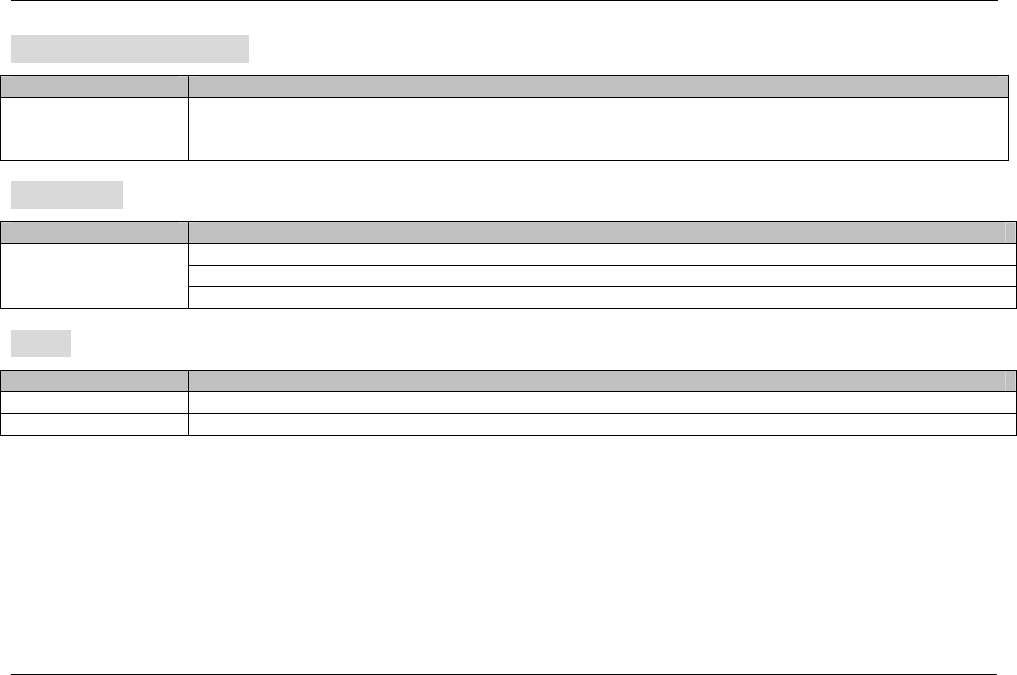
User’ Manual
Page 43 of 43
Stand by / Hibernation
Trouble Solution
Can’t enter into
Standby
/Hibernation
Please check if the Windows Media Player is running. If Yes, the Laptop can’t enter into Standby or
Hibernation mode. Please close Windows Media Player.
IEEE 1394
Trouble Solution
Be sure equipment is firmly connected to the Laptop.
Be sure the equipment is turned on.
Equipments
connected can’t
work Reinstall the driver of the equipment and configure it under the instruction of your OS.
LAN
Trouble Solution
Can’t be connected Be sure the RJ45 connector is firmly connected to the Network Hub or Switch.
Can’t be booted Check the configuration of hardware in BIOS Setup Utility and activate the function of LAN Waken.